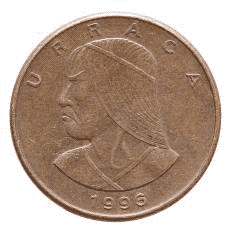Today, Urracá's face is found on the 1 centesimo or "centavo" coin.

Indigenous cacique Urracá fights conquistador Francisco Pizarro
Urracá wins several battles. In one, he creates a rumor of gold to divide the Spaniards leaving them open to ambushes. At his defeat, he refuses to be enslaved. Different versions of events claim he is killed in a battle at his home, or that he is captured and taken to Spain in chains.
Today, Urracá's face is found on the 1 centesimo or "centavo" coin.

"The attention of Pedrarias was directed to the west and north of Panama, rather than to the east and south. In the sierra of Veragua, on the south coast, dwelt a powerful cacique named Urracá. He was reported to have much gold; so Espinosa by sea, and Pizarro by land started out after the mountain chieftain. Urracá sent his women, children, and infirm to a place of safety and fiercely attacked the Spaniards with his fighting men. The licentiate was getting the worst of it, when Hernando de Soto came up with thirty of Pizarro's men and saved the Spaniards. When the latter retreated, the Indians fell upon them in the defiles of the mountains, and it was only by the most desperate efforts that the white men got back to the ships.
"Espinosa wished to found a colony at Nata, the most attractive place yet visited on the Isthmus. He left at Nata fifty men under Companon, and returned to Panama. Urracá threatens Companon by night and kills one of his men, but is scared off by a single Spanish soldier. Runners are despatched for aid, and Hernando Ponce de Leon and the governor himself appear with reinforcements. They go out after Urracá and fight for five days, but are forced to come back to Nata, leaving the cacique unbeaten. Pedrarias divides the lands and captive Indians among such of his soldiers as elect to settle at Nata and sixty choose to remain and start a pueblo. Diego de Albites is left as the governor's lieutenant, and finally makes peace with Urracá; which displeases Pedrarias who appoints Francisco Companon to govern Nata.
"Chiriqui was the name of a province west of Veragua, and Benito Hurtado was sent there to found a settlement. The country was thinly populated, and the two principal chiefs, Vareclas and Burica, submitted without resistance. For two years the colony remained unmolested; but the Spaniards became unbearable, and the Indians rose in revolt. Urracá again took up arms, but was induced to visit Nata under solemn assurance of safety. When in their power, the Spaniards put the chief in irons and sent him to Nombre de Dios, with the intention of shipping him to Spain. Luckily, the brave cacique burst his bonds and returned to his home to wage a relentless warfare against the white invaders. Like his prototype the Quibian, on the north coast of Veragua, Urracá escaped the vengeance of the Christians and died among his own people."
Old Panama and Castilla del Oro by Charles Loftus & Grant Anderson